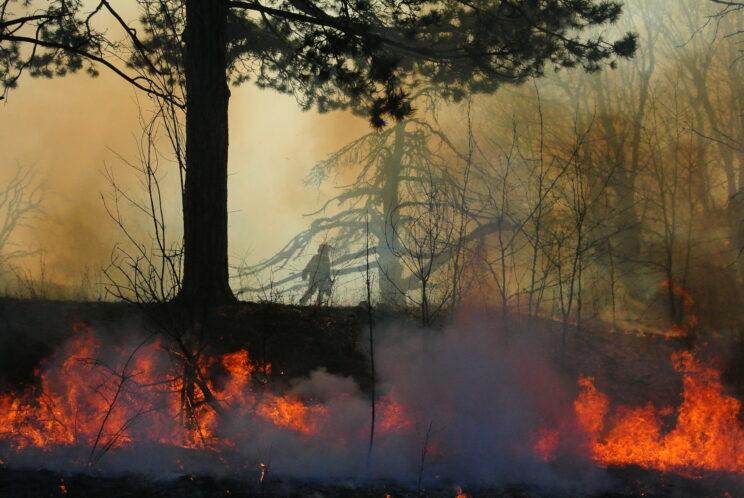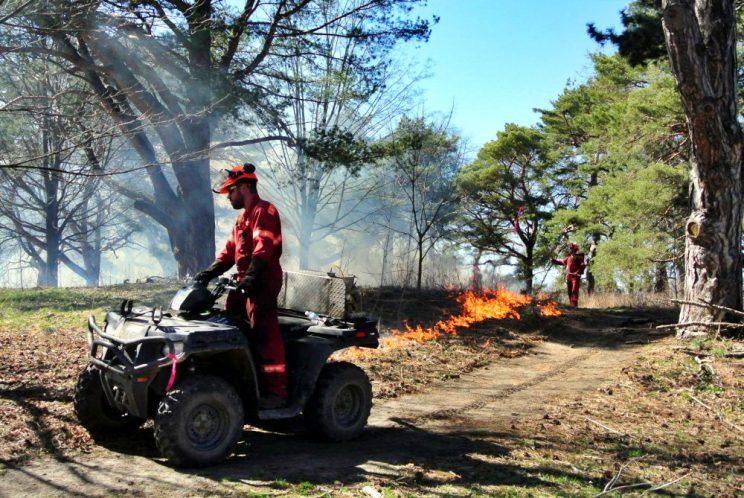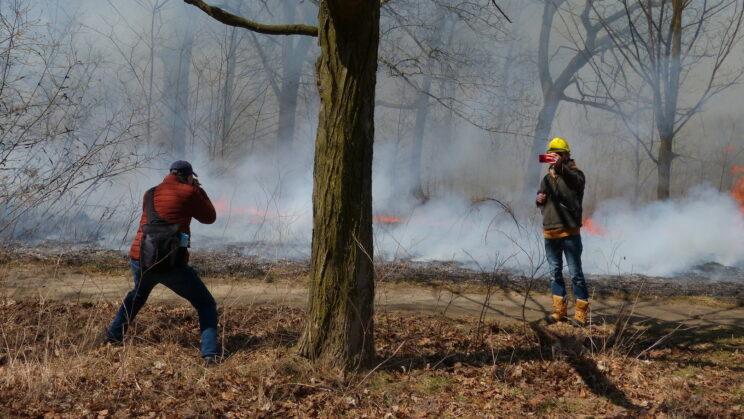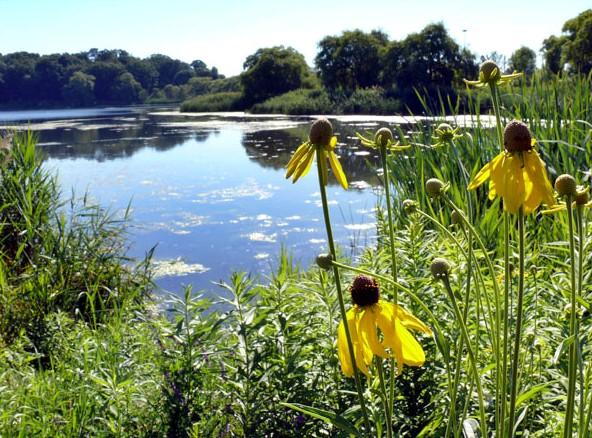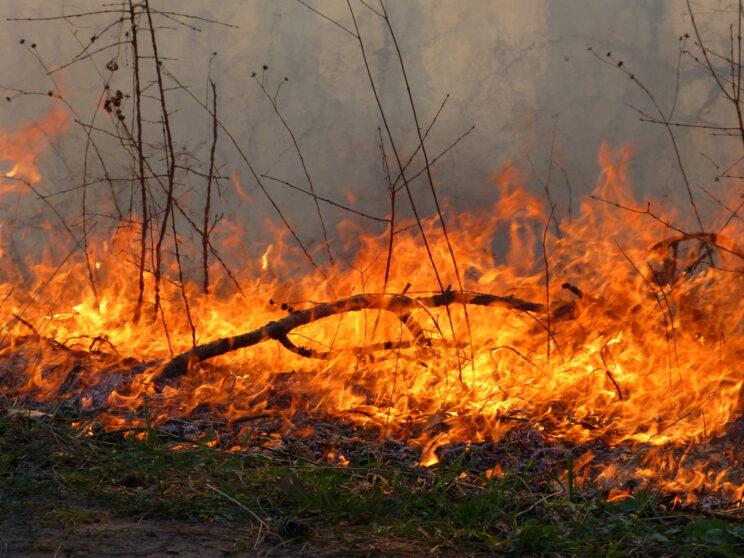Source: City of Toronto Precribed Burn Notices April 2008/2019
A prescribed burn is a deliberately set and carefully controlled low fire that consumes dried leaves, small twigs and grass stems, but does not harm larger trees. Prescribed burns are part of Urban Forestry’s long-term management plan to restore and protect Toronto’s rare black oak woodlands and savannahs.
High Park Prescribed Burn Advance Notice 2025
High Park Traditional and Prescribed Burn Final Notice April 17, 2025
The Role of Fire
Since 2000 City of Toronto Urban Forestry has been using fire as a management tool to help restore and expand High Park native plant communities including the globally rare Black Oak savannah habitat. Different areas of oak savannah are burned on a rotating cycle. (See Summary of Burn Cycle by Management Unit.)
Prior to European settlement, fire played a pivotal role in maintaining the prairies, savannahs and oak forests that once extended across southern Ontario. This included deliberate burns set by Indigenous peoples as well as naturally occurring wildfires. (See Indigenous History of Today's High Park.)
Fire is an important factor in a healthy oak savannah as it helps to encourage and invigorate native species that have evolved to persist in fire controlled systems. Indigenous peoples used fire to maintain lush grasslands that attracted deer and other game for hunting.
Prairie plants including black oaks respond to modified site conditions following the burn, and grow more vigorously than they would have in the absence of the fire. Fire also works in reducing competition from some invading exotic species that are not adapted to a fire controlled ecosystem.
Successes of the High Park Burn Program
The natural fire cycle had been suppressed in High Park for over 100 years. With fairly regular fires occurring since 2000, large improvements have been observed in the distribution and health of native plant species in the park.
The initial goals for the prescribed burn program established in the management plan focused on enhancing the growth of native species while controlling exotic plant species. Special attention was also focused on targeting small rare plant communities existing in High Park in the hope of encouraging their natural expansion. Annual monitoring has shown that many areas in High Park are exhibiting large increases in native plant community patches, as well as a significant decline in some of the exotic species controlled by burning, such as garlic mustard.
High Park is home to many rare and important species that are thriving from prescribed burning. Species in the drier savannah areas are showing large success in expansion such as dryland blueberry, Indian grass, big bluestem, woodland sunflower, sky-blue aster, and a variety of goldenrods and sedges. Wild lupine populations have exhibited an immediate response, with increases in patch size as well as seed production.
In the beginning stages of the prescribed burn program, frequent burns were necessary to reverse the effects of the approximately 100 years of suppressed fire cycles. More frequent burning was required to set-back exotic invasive plants such as buckthorn and honeysuckle, allowing more light to penetrate into the savannah habitats.
Restoration of natural areas is an adaptive process. As the successes of the High Park prescribed burn program continue, the frequency and interval between burns are reevaluated and adjusted accordingly.
Prescribed burn management, in combination with native species planting and invasive species removal, will continue to be a valuable tool used in these rare habitats to ensure their longevity and proliferation.
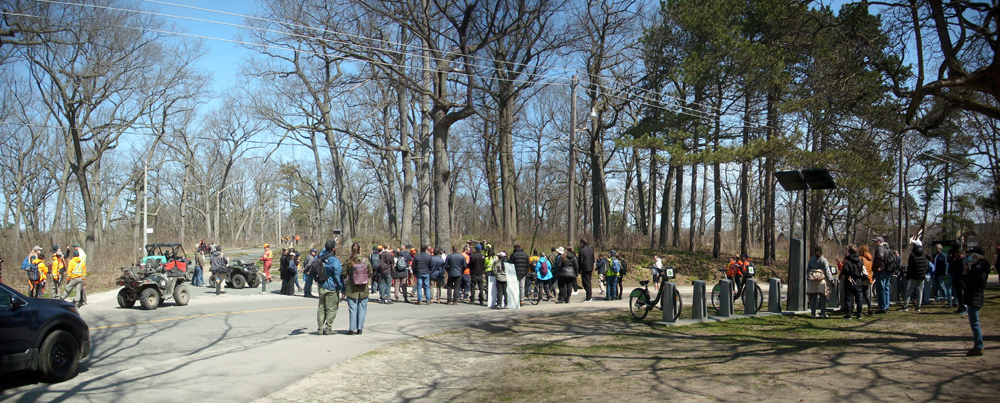
Prescribed Burn Monitoring
Source: Urban Forestry, 2021
Prior to European settlement, the landscape was defined by Indigenous Peoples’ use of controlled burns to manage the landscape, coupled with naturally-occurring wildfires. Indigenous Peoples would use fire to clear the land for agriculture, to rejuvenate the quality and quantity of forage and medicinal plants, and to attract wildlife. This use of fire historically helped to maintain savannah habitat in the area on which High Park is located.
Prescribed burns were re-introduced to High Park by City of Toronto Urban Forestry in the late 1990s as a management tool. This began initially as demonstration plots and then as an annual operational program starting in 2000. Burns are designed to echo these historic controlled and natural fires and benefit native plants and animals by setting back invasive/exotic plant species, stimulating native plant regeneration, restoring wildlife habitat and returning nutrients to the soil.
Management areas within High Park are reviewed annually to monitor the species composition of the areas in relation to each site's individual goals. This review involves monitoring vegetation response to fire by looking at the presence and population size of both native and invasive species, as well as plant vigour, and informs which areas should be considered for the following burn period. Site review would also identify any site preparation needed prior to the burn taking place in order to achieve optimal results. For example, previous results have demonstrated the need to remove invasive shrub cover of a certain size in advance of burns to allow fire to carry through the sites to best encourage native species.
Immediately following the burn, staff evaluate the burn coverage by making site notes of impacts on protected areas, areas that had high heat points, and areas that did not burn as well. Some reasons why areas might not burn as well include dense leaf litter and/or shrub cover, moist conditions, and green non-native plant material. These observations are helpful when later evaluating the vegetation response to fire.
Sites are revisited after a few weeks and/or months following the prescribed burn to monitor plant regeneration and growth to determine progression of the site and plans for future work. This can include management of invasive species that are regenerating or moving into the newly disturbed areas, or identifying areas where the native seed bank is not regenerating and would benefit from planting locally sourced native plants.
Monitoring has shown increases in savannah species such as Wild Blue Lupine and young black oak seedlings following burns, as well as a reduction of some invasive species patches. Monitoring also enables changes to be made in response to site conditions – for example, creating insect refuges within a burn site to protect overwintering insects, or targeting removal of invasive plant species that fire cannot control.
Prescribed burning is an ongoing management practice that benefits the savannahs of High Park and is an integral element in protecting and preserving this valuable place.
Media coverage of past burns:
2025: CityNews Toronto, Toronto Star
2023: Toronto Star "Toronto carries out High Park controlled burn as part of Black Oak protection". CBC: "Why is High Park on fire? How Indigenous-led prescribed burns protect the land".
2022: Toronto Star "Where there's smoke, there's renewal" online or the Pressreader version or this pdf of the print version. Global News City of Toronto conducts prescribed burn at High Park
2018: CBC News: High Park carries out 3 controlled burns with help of 'fire boss'
2017: Toronto Star article, Apr. 18/17
2016: Toronto Star
2015: NOW Magazine article with photos, April 16, 2015, CTV News article, April 2015, The Guardian photo highlight of the day, April 16, 2015
2013: Torontoist, blogTO, Toronto Star video
2012: NOW, blogTO, Torontoist
2011: Torontoist, blogTO, YouTube
Art Projects based on High Park Burns:
- Alchemical Cinema: Land Breath Fire. Sound by Allison Cameron, in a controlled burn of the forest in High Park. Watch video
- Frances Patella Smoke & Fire series
Sources
See also
- High Park Prescribed Burn Cycle by Management Unit summary (2000-22). Source: Urban Forestry and High Park Management Unit Map, Source: Urban Forestry
- High Park Prescribed Burn factsheet. Source: Urban Forestry
- City of Toronto Urban Forest Management
- City of Toronto - Prescribed Burns
- Tallgrass Ontario Fire Factsheet
- Oak Savannah Restoration in Toronto: A Progress Report presentation by Beth McEwen and Jennifer Gibb, City of Toronto, Forestry, Wildland Fire Canada conference October 2010
- Setting Fires and Restoring an American Landscape. Source: New York Times
- Fire History Reconstruction in the Black Oak (Quercus velutina) Savanna of High Park, Toronto. Dinh, T., N. Hewitt & T.D. Drezner. 2015. Natural Areas Journal




